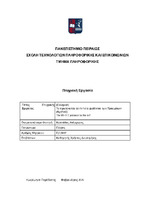Το πρωτόκολλο Wi-Fi 7 στο Διαδίκτυο των Πραγμάτων
The Wi-Fi 7 protocol in the IoT

View/
Keywords
Διαδίκτυο των Πραγμάτων ; Πρωτόκολλο Wi-Fi 7 ; Δίκτυα ; Internet of ThingsAbstract
This thesis provides an in-depth analysis of Wi-Fi 7, IEEE 802.11, the next generation of
wireless networking, and the transformation it promises to bring. Significant improvements to
the protocol include increased channel bandwidth, increased spatial streams, higher-order
modulation, multi-link operation, and multi-resource unit aggregation. These features were
intended to meet the increasing demands for extremely high speeds, very low latency, efficient
spectrum utilization, and reliable connectivity that differentiate Wi-Fi 7 from previous
generations.
The thesis explores Wi-Fi 7 in practical implementation applications in the areas of enterprise
networking, smart homes, IoT, gaming, streaming, and industrial automation. Leveraging
advanced features such as better OFDMA (Orthogonal Frequency Division Multiple Access),
Target Wake Time, and multi-link operation, Wi-Fi 7 enables use cases from high-capacity
enterprise systems to low-latency gaming and precise industrial automation.
Furthermore, information is provided on Wi-Fi 7 and its challenges, limiting factors,
infrastructure, compatibility with old device frameworks, and security vulnerabilities. Shedding
light on the issues that complicate the adoption of new standards in terms of backward
compatibility and data protection.
Looking ahead and beyond Wi-Fi 7, the thesis examines the potential future of wireless
networking, the integration of 5G/6G networks, and the adoption of artificial
intelligence/machine learning for improved connectivity and resource management.
Therefore, it examines Wi-Fi 7 for advanced global connectivity in its holistic perspective, citing
technical advantages, real-world applications, and future prospects that could make Wi-Fi 7
one of the cornerstones of next-generation wireless networking.


